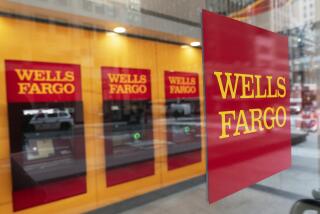Wells Fargo a mixed bag as stock prospect
- Share via
Question: Can I expect the performance of Wells Fargo & Co.’s stock to improve?
Answer: No one these days is doing handsprings over the prospects of banks, including Wells Fargo, a top-tier nationwide institution and the largest originator of home loans.
Although the company has weathered its 2008 acquisition of Wachovia Corp. better than analysts had expected and is financially stronger than many rivals, its mortgage and home equity portfolios still bear close watching.
The San Francisco firm also faces lawsuits from investors, brokerage firms and government-sponsored agencies over alleged misstatements or omissions in its underwriting of residential mortgage-backed securities. The bank recently agreed to pay $100 million to Citigroup Inc. to resolve claims that it unfairly pulled Wachovia away from an acquisition by Citigroup.
Unlike some other banks, Wells Fargo has declined to halt its seizures of residential property, defending its home-foreclosure procedures as “sound and accurate.”
Shares of Wells Fargo are down 1.3% so far this year after falling 8.4% last year. The Federal Reserve is expected to permit the company to increase its dividend early next year.
The company’s profit more than quadrupled to $12.3 billion last year from $2.7 billion in 2008. Its earnings were up 3.2% in the third quarter of 2010 compared with a year earlier, thanks to low interest rates that boosted demand for mortgage refinancings. But delinquent loans and other nonperforming assets rose to 4.6% of total assets, up from 2.9% a year earlier.
Wall Street analysts on average project that Wells Fargo’s earnings will climb 26% this year and 28% next year.
Analyst ratings on Wells Fargo consist of nine “strong buys,” 13 “buys,” six “holds,” two “underperforms” and one “sell,” according to Thomson Reuters.
Question: What has happened to Ivy Asset Strategy? This was supposed to be a great fund.
Answer: This bold yet volatile mutual fund has a better long-term than short-term track record.
The $24-billion fund’s Class A shares have a five-year annualized return of 11%, ranking in the top 4% of so-called world allocation funds. But its 12-month total return of 4.2% puts it in the bottom one-third of the category.
Managers of the fund often make significant shifts in its holdings, which can include large positions in hard-to-predict emerging markets, precious metals and currencies. It often hedges a large portion of its portfolio using futures contracts and also engages in short selling. For several asset classes, there is no minimum or maximum amount that can be owned.
The fund imposes a 5.75% sales charge on purchases of Class A shares. The annual expense ratio paid by Class A shareholders is 1.05%. The minimum initial investment is $500.
Andrew Leckey answers questions only by e-mail. Write to him at yourmoney@tribune.com.
More to Read
Inside the business of entertainment
The Wide Shot brings you news, analysis and insights on everything from streaming wars to production — and what it all means for the future.
You may occasionally receive promotional content from the Los Angeles Times.








